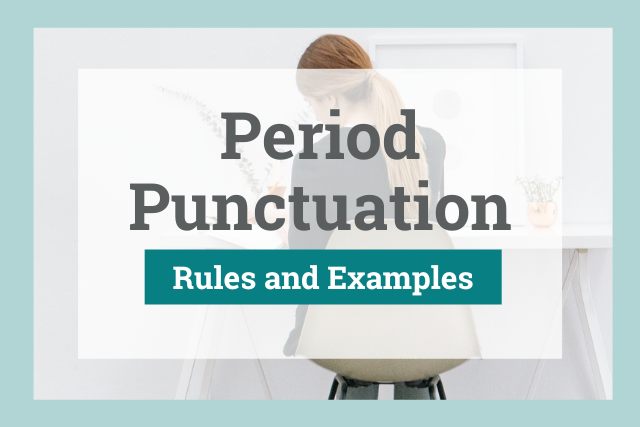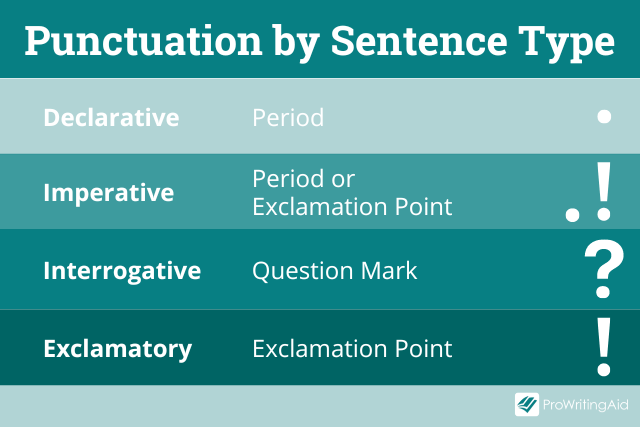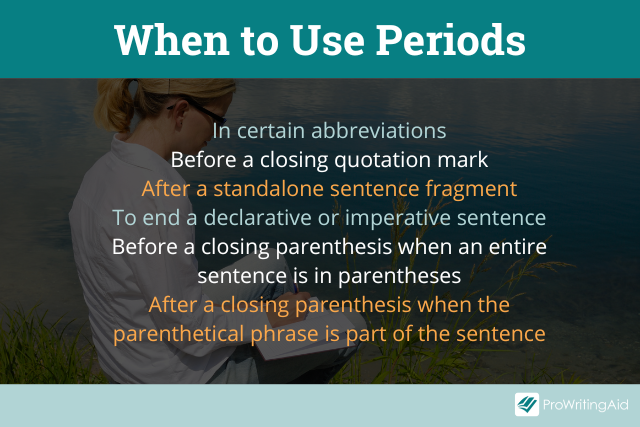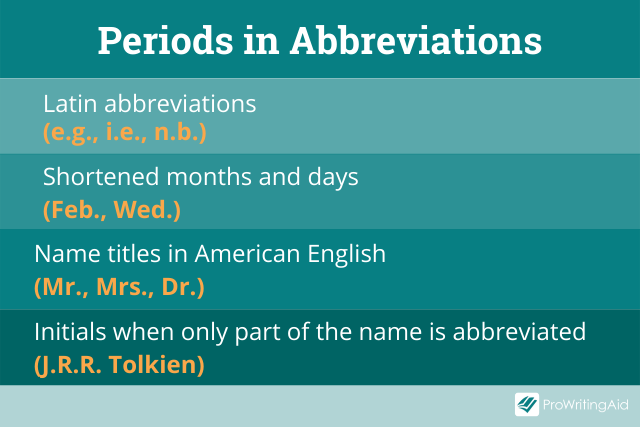Period Punctuation: Rules and Examples

The period punctuation mark is the most common ending punctuation mark in English. Today, we’ll learn what the period is and when to use it.
What Is the Period Symbol?
The period symbol is a dot that marks the end of a sentence. The other punctuation marks that end a sentence are exclamation points and question marks.

There are four main types of sentences. An interrogative sentence is a question and uses a question mark.
An exclamatory sentence ends with an exclamation point and shows excitement or another strong emotion.
An imperative sentence is a command. You can use an exclamation point or a period with this type of sentence.
A declarative sentence is a statement; it’s not a question, command, or exclamation. Periods usually end declarative sentences. Most sentences are declarative sentences; in fact, every sentence in this article thus far has been declarative.
ProWritingAid’s free grammar checker can make sure you’re always using the correct punctuation with each sentence type.

What Does the Period at the End Signify?
A period signifies that a sentence is complete. It also tells you you’ve read either a declarative or imperative sentence.
Knowing the type of sentence helps you understand the tone. You’ll know that the sentence doesn’t carry an abundance of emotion, nor should it end with an inflection like a question.
When to Use a Period in a Sentence

While the primary function of a period is to end a sentence, there are several other uses. Here are four additional rules for using periods.
Periods and Sentence Fragments
Sometimes, we use sentence fragments in our writing. This is especially true in creative writing, whether fiction or non-fiction, as well as informal writing, like social media posts and texts.
A period isn’t just for complete sentences. It can also mark the end of a sentence fragment. In creative writing, sentence fragments with periods can add emphasis to an important idea.
The period helps pack a punch because it’s saying the fragment is just as important as a declarative sentence.
Example: Never again. I’ll never trust another person as long as I live. Not in five years. Not in a hundred.
Periods and Quotation Marks
Quotation marks are a tricky type of punctuation because they override other punctuation rules.
While they aren’t considered an ending punctuation, closing quotation marks can appear at the very end of a sentence.
However, there must be an ending punctuation mark before the final quotation mark.
In American English, always place a period before the closing quotation mark. You end the sentence, then you end the quote.
Example: Emily Dickinson wrote, “If I can stop one heart from breaking, I shall not live in vain.”
Periods and Parentheses
Parentheses are even more confusing than quotation marks because there are two rules involving them and periods.
First, if parentheses enclose a complete sentence, place the period inside the closing parenthesis.
Example: I rode the bus to my meeting. (The bus was late, of course.) The meeting went well and ended early, so I grabbed a bite to eat before calling a taxi.
The second rule is if the parentheses are inside an existing sentence, place the period after the closing parenthesis.
Example: To get to my meeting, I rode the bus (which was late).
Periods and Abbreviations
Periods also belong in certain abbreviations. In American English, use a period at the end of titles, like Mr., Mrs., Ms., Sr., and Dr.
You will also use a period with someone’s initials if they use initials in part of their name, like F. Scott Fitzgerald and A.A. Milne. Omit the period for a name that is all initials, like MLK.

Always use a period with Latin abbreviations, like e.g., i.e., n.b., and etc. Use periods in non-metric measurement abbreviations (e.g. lbs.) but not metric abbreviations (e.g. cm).
Shortened forms of month and day names use periods, like Dec. for December and Tues. for Tuesday.
The punctuation in other abbreviations, including acronyms, depends on the individual situation and style guide being used.
Period Punctuation Examples
Let’s take a look at a few more examples of period punctuation in sentences.
- I told him to leave. To walk away and never look back.
- Martin Luther King Jr. said, “The arc of the moral universe is long, but it bends toward justice.”
- Dr. Smith is a great doctor (and affordable).
- On Nov. 13, my son was 27 in. long.
Learning these period punctuation rules will ensure you use periods correctly every time.